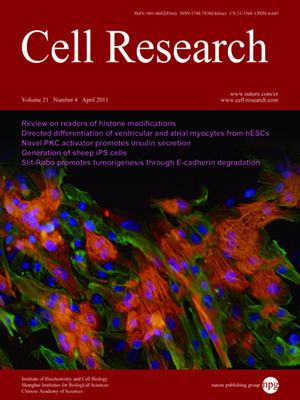
Volume 21, No 4, Apr 2011
ISSN: 1001-0602
EISSN: 1748-7838 2018
impact factor 17.848*
(Clarivate Analytics, 2019)
Volume 21 Issue 4, April 2011: 588-599
ORIGINAL ARTICLES
Identification of a small molecule activator of novel PKCs for promoting glucose-dependent insulin secretion
Shuai Han1,*, Heling Pan2,*, Jianhua Zhang1, Li Tan2, Dawei Ma2, Junying Yuan3 and Jia-Rui Wu1,4
1Key Laboratory of Systems Biology, Institute of Biochemistry and Cell Biology, Shanghai Institutes for Biological Sciences, Chinese Academy of Sciences, Shanghai 200031, China
2Shanghai Institute of Organic Chemistry, Chinese Academy of Sciences, Shanghai 200032, China
33Department of Cell Biology, Harvard Medical School, Boston, MA 02115, USA
44Hefei National Laboratory for Physical Sciences at Microscale and School of Life Sciences, University of Science & Technology of China, Hefei, 230027, China
Correspondence: Jia-Rui Wu, Junying Yuan,(wujr@sibs.ac.cn; jyuan@hms.harvard.edu)
Using an image-based screen for small molecules that can affect Golgi morphology, we identify a small molecule, Sioc145, which can enlarge the Golgi compartments and promote protein secretion. More importantly, Sioc145 potentiates insulin secretion in a glucose-dependent manner. We show that Sioc145 selectively activates novel protein kinase Cs (nPKCs; δ and ε) but not conventional PKCs (cPKCs; α, βI and βII) in INS-1E insulinoma cells. In contrast, PMA, a non-selective activator of cPKCs and nPKCs, promotes insulin secretion independent of glucose concentrations. Furthermore, we demonstrate that Sioc145 and PMA show differential abilities in depolarizing the cell membrane, and suggest that Sioc145 promotes insulin secretion in the amplifying pathway downstream of K
ATP channels. In pancreatic islets, the treatment with Sioc145 enhances the second phase of insulin secretion. Increased insulin granules close to the plasma membrane are observed after Sioc145 treatment. Finally, the administration of Sioc145 to diabetic GK rats increases their serum insulin levels and improves glucose tolerance. Collectively, our studies identify Sioc145 as a novel glucose-dependent insulinotropic compound via selectively activating nPKCs.
Cell Research (2011) 21:588-599. doi:10.1038/cr.2010.137; published online 28 September 2010
FULL TEXT | PDF
Browse 2030


